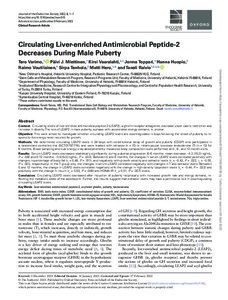Circulating Liver-enriched Antimicrobial Peptide-2 Decreases During Male Puberty
Vaaralahti Kirsi; Raivio Taneli; Tenhola Sirpa; Voutilainen Raimo; Huopio Hanna; Hero Matti; Varimo Tero; Toppari Jorma; Miettinen Päivi J
https://urn.fi/URN:NBN:fi-fe2022081153831
Tiivistelmä
Context: Circulating levels of liver-enriched antimicrobial peptide 2 (LEAP2), a ghrelin receptor antagonist, decrease under caloric restriction and increase in obesity. The role of LEAP2 in male puberty, a phase with accelerated energy demand, is unclear.
Objective: This work aimed to investigate whether circulating LEAP2 levels are downregulated in boys following the onset of puberty to respond to the energy need required for growth.
Methods: We determined circulating LEAP2 levels in 28 boys with constitutional delay of growth and puberty (CDGP) who participated in a randomized controlled trial (NCT01797718), and were treated with letrozole (n = 15) or intramuscular low-dose testosterone (T) (n = 13) for 6 months. Blood sampling and dual-energy x-ray absorptiometry-measured body composition were performed at 0-, 6-, and 12-month visits.
Results: Serum LEAP2 levels decreased statistically significantly during pubertal progression (0-6 months: mean decrease -4.3 [10.3] ng/mL, P = .036 and 0-12 months: -3.9 [9.3] ng/mL, P = .033). Between 0 and 6 months, the changes in serum LEAP2 levels correlated positively with changes in percentage of body fat (r s = 0.48, P = .011), and negatively with growth velocity and estradiol levels (r s = -0.43, P = .022, r s = -0.55, P = .003, respectively). In the T group only, the changes in serum LEAP2 correlated negatively with changes in T and estradiol levels. Between 0 and 12 months, the change in LEAP2 levels correlated negatively with the change in high-density lipoprotein levels (r s = -0.44, P = .022) and positively with the change in insulin (r s = 0.50, P = .009) and HOMA-IR (rs = 0.51, P = .007) levels.
Conclusion: Circulating LEAP2 levels decreased after induction of puberty reciprocally with increased growth rate and energy demand, reflecting the metabolic state of the adolescent. Further, the results suggest that estradiol levels may have a permissive role in downregulating circulating LEAP2 levels.
Kokoelmat
- Rinnakkaistallenteet [19207]
